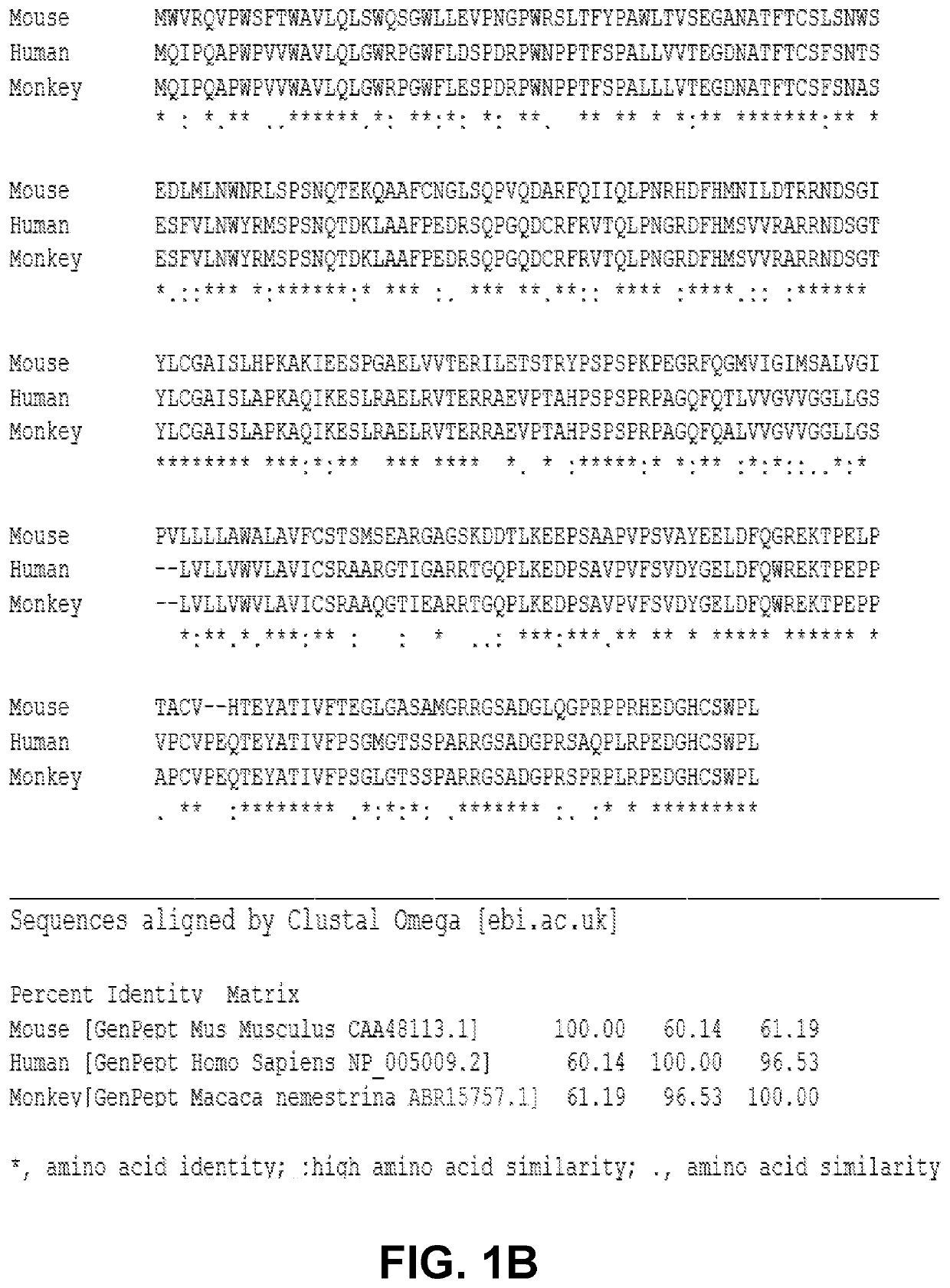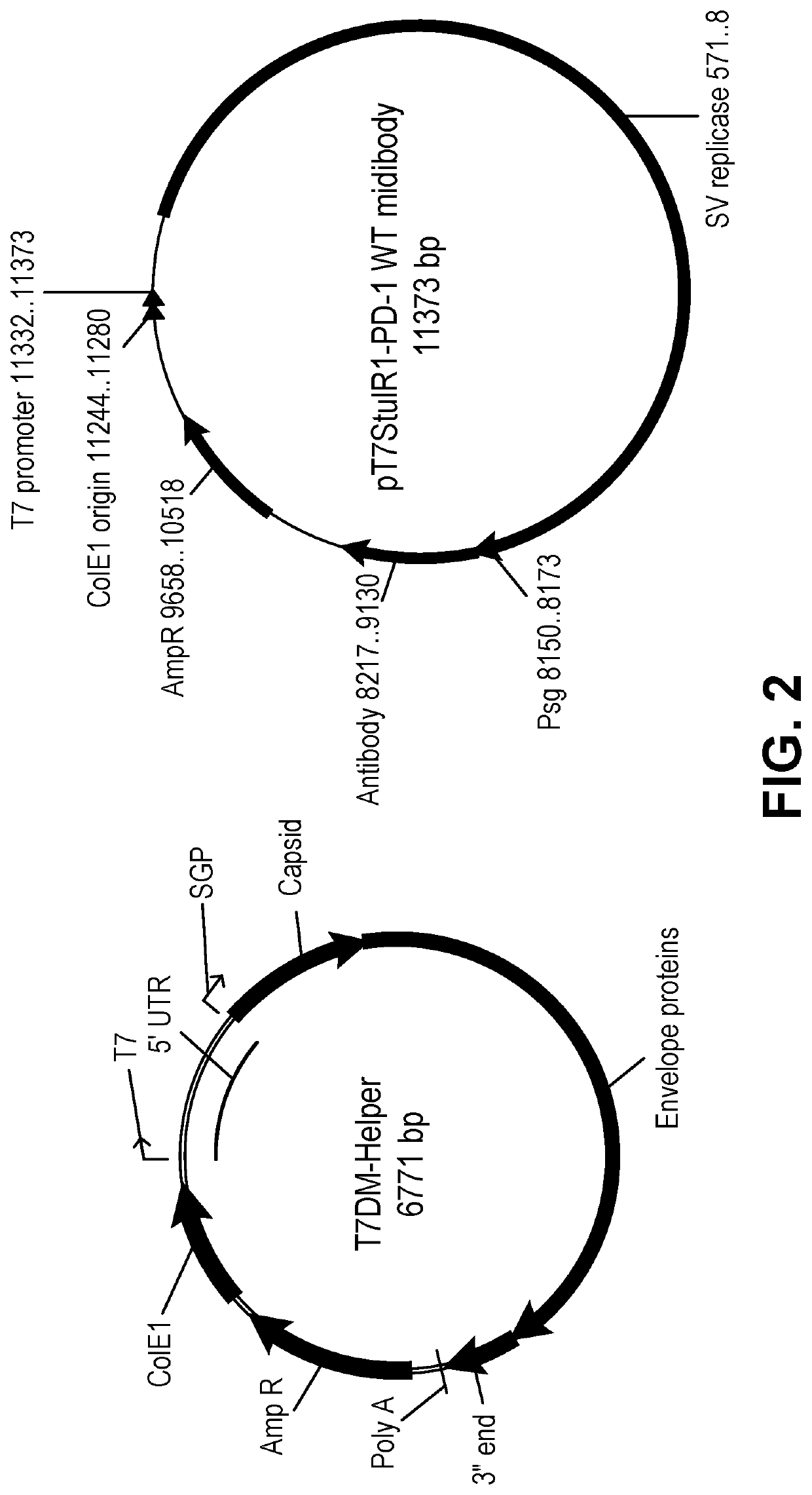Induction and enhancement of antitumor immunity involving sindbis virus vectors expressing immune checkpoint proteins
a technology of immune checkpoint protein and sindbis virus, which is applied in the direction of tumor specific antigens, drug compositions, peptides, etc., can solve the problems of resistance to inhibitors, tumor cells may not be efficiently targeted, and the treatment approach using oncolytic viruses has not generally led to complete cancer or tumor remission, so as to enhance the anti-tumor effect of t cells, enhance the immune response, and improve the effect of immunity
- Summary
- Abstract
- Description
- Claims
- Application Information
AI Technical Summary
Benefits of technology
Problems solved by technology
Method used
Image
Examples
example 1
[0175]Vector preparation: Construction of recombinant viral vectors was performed using standard techniques well known to those of ordinary skill in the field of molecular biology, including, but not limited to, plasmid purification, restriction endonuclease digestion, ligation, transformation, polymerase chain reaction and DNA sequencing (e.g., Current Protocols in Molecular Biology, E M. Ausubel et al. (Eds), John Wiley and Sons, Inc., NY, USA. (1998) and Molecular Cloning: A Laboratory Manual (2nd Ed.), J. Sambrook, E. F. Fritsch and T. Maniatis (Eds), Cold Spring Harbor Laboratory Press, NY, USA. (1989)).
[0176]For the experiments using Sindbis viral vector encoding PD-1 (SV / PD-1) and SV / Fluc and SV / GFP as control vectors, the vectors were produced as previously described. (Tseng J. C. et al, 2004, Nat. Biotechnol., 22:70-77). Briefly, plasmids carrying the replicon (SinRep5-LacZ, SinRep5-GFP, or SinRep5-Fluc) or DHBB helper RNAs (SinRep5-tBB) were linearized with XhoI (for SinRe...
example 2
irus Vector Encoding the Immune Checkpoint Protein PD-1 Provided Anti-tumor Efficacy In Vivo
[0182]This Example describes studies conducted utilizing a Sindbis virus vector which contained a polynucleotide encoding the extracellular portion of PD-1, a checkpoint protein (receptor protein) expressed by T cells, which plays a role in downregulating the immune response.
Materials and Methods
Cell Lines
[0183]Baby hamster kidney cells (BHK-21; ATTC CCL-10) were maintained in minimum essential α-modified medium (α-MEM) (Corning CellGro) supplemented to contain 5% fetal bovine serum (FCS, Gibco) and 100 mg / mL penicillin-streptomycin (Corning CellGro). BHKSINLuc2 cells (ATCC CRL12071) were cultured in a manner similar to that of BHK cells, and 400 μg / mL Geneticin was included in the culture medium.
[0184]The BALB / c colon carcinoma (CT26) cell line was obtained from the American Type Culture Collection (ATCC: CRL 2638). Firefly luciferase (Fluc)-expressing CT26 cells (CT26.Fluc) were generated b...
example 3
irus Vector Encoding the Immune Checkpoint Protein 4-1BB Ligand (4-1BBL)
[0191](4-1BB ligand) is a transmembrane cytokine that is part of the tumor necrosis factor (TNF) ligand superfamily. 4-1BBL is a bidirectional signal transduction molecule that serves as a ligand for 4-1BB (alternatively called “tumor necrosis factor receptor superfamily member 9 (TNFRSF9), CD137, and “induced by lymphocyte activation” (ILA)), which is a costimulatory receptor / immune checkpoint molecule expressed by T cells. 4-1BBL and its receptor, 4-1BB (TNFRSF9), play a role in antigen presentation by cells of the immune system, e.g., dendritic cells, macrophages, APC, and in the generation of cytotoxic T cells. While the 4-1BB receptor (4-1BBR) is absent from resting T cells, its expression is rapidly induced in T cells upon antigenic stimulation. 4-1BB reactivates anergic T cells and promotes T cell proliferation. 4-1BBL is involved in generating an optimal response in CD8+ T cells. 4-1BBL is also expressed...
PUM
| Property | Measurement | Unit |
|---|---|---|
| Therapeutic | aaaaa | aaaaa |
| Immunogenicity | aaaaa | aaaaa |
Abstract
Description
Claims
Application Information
 Login to View More
Login to View More - R&D
- Intellectual Property
- Life Sciences
- Materials
- Tech Scout
- Unparalleled Data Quality
- Higher Quality Content
- 60% Fewer Hallucinations
Browse by: Latest US Patents, China's latest patents, Technical Efficacy Thesaurus, Application Domain, Technology Topic, Popular Technical Reports.
© 2025 PatSnap. All rights reserved.Legal|Privacy policy|Modern Slavery Act Transparency Statement|Sitemap|About US| Contact US: help@patsnap.com



